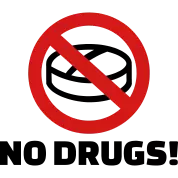
This image has format transparent PNG with resolution x.
You can download this image in best resolution from this page and use it for design and web design.
No drugs PNG with transparent background you can download for free, just click on download button.
A drug is any substance (other than food that provides nutritional support) that, when inhaled, injected, smoked, consumed, absorbed via a patch on the skin, or dissolved under the tongue causes a physiological (and often psychological) change in the body.
In pharmacology, a drug is a chemical substance of known structure, other than a nutrient of an essential dietary ingredient, which, when administered to a living organism, produces a biological effect. A pharmaceutical drug, also called a medication or medicine, is a chemical substance used to treat, cure, prevent, or diagnose a disease or to promote well-being. Traditionally drugs were obtained through extraction from medicinal plants, but more recently also by organic synthesis. Pharmaceutical drugs may be used for a limited duration, or on a regular basis for chronic disorders.
Pharmaceutical drugs are often classified into drug classes—groups of related drugs that have similar chemical structures, the same mechanism of action (binding to the same biological target), a related mode of action, and that are used to treat the same disease. The Anatomical Therapeutic Chemical Classification System (ATC), the most widely used drug classification system, assigns drugs a unique ATC code, which is an alphanumeric code that assigns it to specific drug classes within the ATC system. Another major classification system is the Biopharmaceutics Classification System. This classifies drugs according to their solubility and permeability or absorption properties.
Psychoactive drugs are chemical substances that affect the function of the central nervous system, altering perception, mood or consciousness. They include alcohol, a depressant (and a stimulant in small quantities), and the stimulants nicotine and caffeine. These three are the most widely consumed psychoactive drugs worldwide and are also considered recreational drugs since they are used for pleasure rather than medicinal purposes. Other recreational drugs include hallucinogens, opiates and amphetamines and some of these are also used in spiritual or religious settings. Some drugs can cause addiction and all drugs can have side effects. Excessive use of stimulants can promote stimulant psychosis. Many recreational drugs are illicit and international treaties such as the Single Convention on Narcotic Drugs exist for the purpose of their prohibition.
A medication or medicine is a drug taken to cure or ameliorate any symptoms of an illness or medical condition. The use may also be as preventive medicine that has future benefits but does not treat any existing or pre-existing diseases or symptoms. Dispensing of medication is often regulated by governments into three categories—over-the-counter medications, which are available in pharmacies and supermarkets without special restrictions; behind-the-counter medicines, which are dispensed by a pharmacist without needing a doctor's prescription, and prescription only medicines, which must be prescribed by a licensed medical professional, usually a physician.
In the United Kingdom, behind-the-counter medicines are called pharmacy medicines which can only be sold in registered pharmacies, by or under the supervision of a pharmacist. These medications are designated by the letter P on the label. The range of medicines available without a prescription varies from country to country. Medications are typically produced by pharmaceutical companies and are often patented to give the developer exclusive rights to produce them. Those that are not patented (or with expired patents) are called generic drugs since they can be produced by other companies without restrictions or licenses from the patent holder.
Pharmaceutical drugs are usually categorised into drug classes. A group of drugs will share a similar chemical structure, or have the same mechanism of action, the same related mode of action or target the same illness or related illnesses. The Anatomical Therapeutic Chemical Classification System (ATC), the most widely used drug classification system, assigns drugs a unique ATC code, which is an alphanumeric code that assigns it to specific drug classes within the ATC system. Another major classification system is the Biopharmaceutics Classification System. This groups drugs according to their solubility and permeability or absorption properties.
There are numerous governmental offices in many countries that deal with the control and oversee of drug manufacture and use, and the implementation of various drug laws. The Single Convention on Narcotic Drugs is an international treaty brought about in 1961 to prohibit the use of narcotics save for those used in medical research and treatment. In 1971, a second treaty the Convention on Psychotropic Substances had to be introduced to deal with newer recreational psychoactive and psychedelic drugs.
The legal status of Salvia divinorum varies in many countries and even in states within the United States. Where it is legislated against the degree of prohibition also varies.
The Food and Drug Administration (FDA) in the United States is a federal agency responsible for protecting and promoting public health through the regulation and supervision of food safety, tobacco products, dietary supplements, prescription and over-the-counter medications, vaccines, biopharmaceuticals, blood transfusions, medical devices, electromagnetic radiation emitting devices, cosmetics, animal foods and veterinary drugs.
In this clipart you can download free PNG images: No drugs PNG images free download